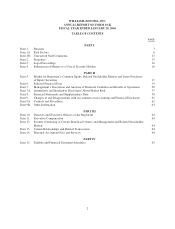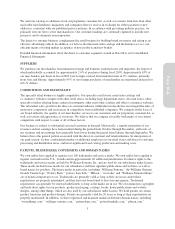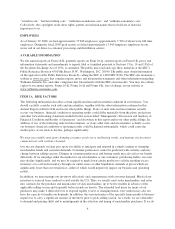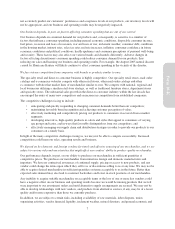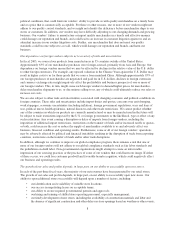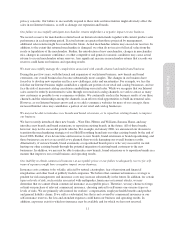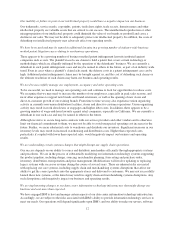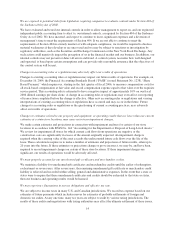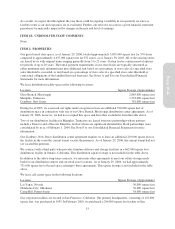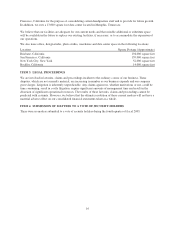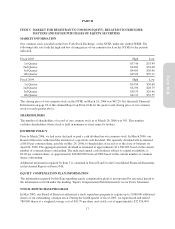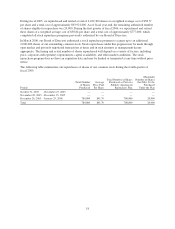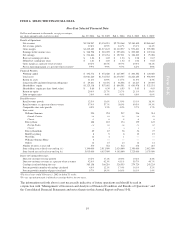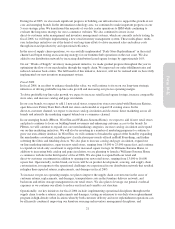Pottery Barn 2005 Annual Report Download - page 24
Download and view the complete annual report
Please find page 24 of the 2005 Pottery Barn annual report below. You can navigate through the pages in the report by either clicking on the pages listed below, or by using the keyword search tool below to find specific information within the annual report.Our inability or failure to protect our intellectual property would have a negative impact on our business.
Our trademarks, service marks, copyrights, patents, trade dress rights, trade secrets, domain names and other
intellectual property are valuable assets that are critical to our success. The unauthorized reproduction or other
misappropriation of our intellectual property could diminish the value of our brands or goodwill and cause a
decline in our sales. We may not be able to adequately protect our intellectual property. In addition, the costs of
defending our intellectual property may adversely affect our operating results.
We have been sued and may be named in additional lawsuits in a growing number of industry-wide business
method patent litigation cases relating to our business operations.
There appears to be a growing number of business method patent infringement lawsuits instituted against
companies such as ours. The plaintiff in each case claims to hold a patent that covers certain technology or
methodologies which are allegedly infringed by the operation of the defendants’ business. We are currently a
defendant in such patent infringement cases and may be named in others in the future, as part of an industry-wide
trend. Even in cases where a plaintiff’s claim lacks merit, the defense costs in a patent infringement case can be
high. Additional patent infringement claims may be brought against us, and the cost of defending such claims or
the ultimate resolution of such claims may harm our business and operating results.
We need to successfully manage our employment, occupancy and other operating costs.
To be successful, we need to manage our operating costs and continue to look for opportunities to reduce costs.
We recognize that we may need to increase the number of our employees, especially in peak sales seasons, and
incur other expenses to support new brands and brand extensions, as well as the opening of new stores and
direct-to-customer growth of our existing brands. From time to time we may also experience union organizing
activity in currently non-union distribution facilities, stores and direct-to-customer operations. Union organizing
activity may result in work slowdowns or stoppages and higher labor costs. In addition, there appears to be a
growing number of wage-and-hour lawsuits against retail companies, especially in California. We are currently a
defendant in one such case and may be named in others in the future.
Although we strive to secure long-term contracts with our service providers and other vendors and to otherwise
limit our financial commitment to them, we may not be able to avoid unexpected operating cost increases in the
future. Further, we incur substantial costs to warehouse and distribute our inventory. Significant increases in our
inventory levels may result in increased warehousing and distribution costs. Higher than expected costs,
particularly if coupled with lower than expected sales, would negatively impact our business and operating
results.
We are undertaking certain systems changes that might disrupt our supply chain operations.
Our success depends on our ability to source and distribute merchandise efficiently through appropriate systems
and procedures. We are in the process of substantially modifying our information technology systems supporting
the product pipeline, including design, sourcing, merchandise planning, forecasting and purchase order,
inventory, distribution, transportation and price management. Modifications will involve updating or replacing
legacy systems with successor systems during the course of several years. There are inherent risks associated
with replacing our core systems, including supply chain and merchandising systems disruptions that affect our
ability to get the correct products into the appropriate stores and delivered to customers. We may not successfully
launch these new systems, or the launch may result in supply chain and merchandising systems disruptions. Any
such disruptions could negatively impact our business and operating results.
We are implementing changes to our data center information technology infrastructure that might disrupt our
business and cost more than expected.
We have engaged IBM to host and manage certain aspects of our data center information technology infrastructure.
Accordingly, we are subject to the risks associated with IBM’s ability to provide information technology services to
meet our needs. Our operations will depend significantly upon IBM’s and our ability to make our servers, software
12


